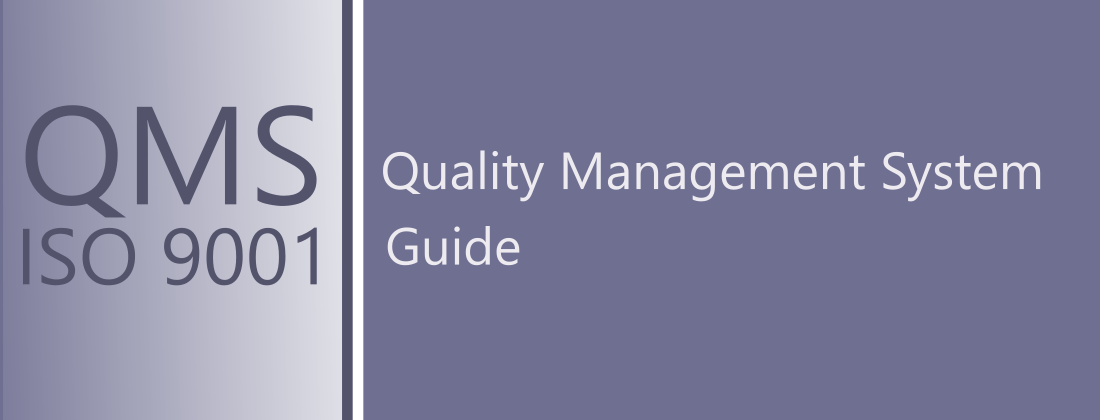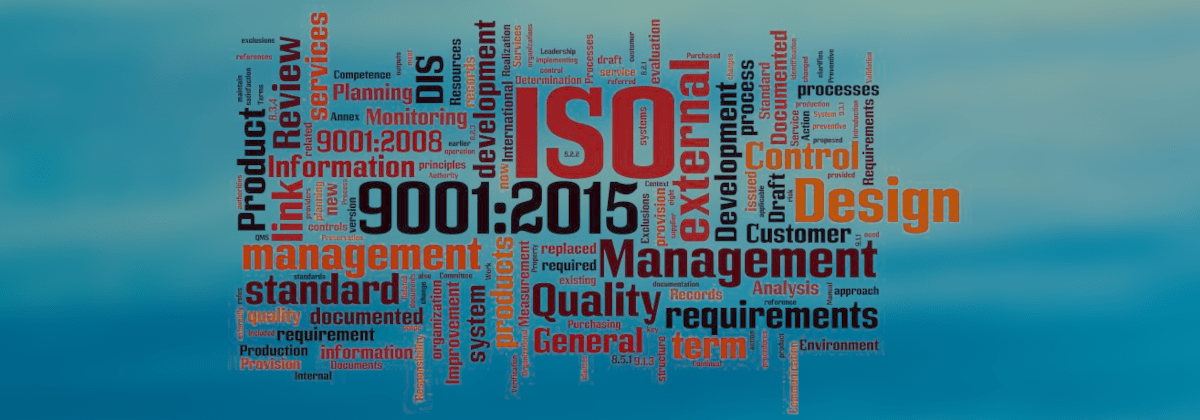When you decide to build a management system compliant with ISO 9001:2015 in your organization, you focus on development and modernity thanks to the implementation of management solutions and techniques based on:
- Process management
- Management by objectives
- Quantitative management
When implementing the ISO 9001 standard in your company, you should maintain a pragmatic approach to its individual requirements. Only such an attitude guarantees your success in your undertaking.
To build and certify a quality management system according to ISO 9001: 2015, the following assumptions should be taken:
I implement ISO in order to:
- Each of the participants of My Company knows exactly their place and the scope of tasks to be performed
- Each of the participants of My Company, on their own initiative, undertakes activities aimed at satisfying the client’s needs and improving our company (of course, in a controlled manner)
- Every customer who comes to us gets exactly what he needs (from our offer)
- Eliminate legitimate complaints and actions that force us to incur additional costs
- Simplify the flow of information as much as possible.
- Limit the number of documents generated by the company to a minimum
ISO is supposed to bring us certain benefits, and the expenditures we incur should at least be returned to us!
Please, note that:
The company should not be adopted to meet the requirements of ISO 9001 !!!
The requirements of ISO 9001 should be adapted to the company!
System implementation should result in:
Increasing the value of the company’s brand through the Certificate ISO 9001:2015 Quality Management System
- Increasing work efficiency
- Increasing customer satisfaction
- Increasing the number of repeat orders
- Increasing the effectiveness of bidding to the client
- Reducing the response time to customer inquiries
- Minimizing of incurred expenses
- Shorting adaptation time for new employees.
If we want to achieve above mentioned results, we should use below methodology during ISO implementation.
Exact diagnosis:
Before starting, we should ask ourselves about one important thing: whether we implement ISO 9001 ourselves or are we looking for help from the outside?
BY OURSELVES:
If we take up this challenge on our own, a person should be appointed to act as the Quality Management System Representative (Deputy Owner / President for Quality). It should be a person with a good knowledge of business management issues, preferably with experience in a managerial position (medium or higher), responsible and not afraid to make decisions, sometimes revolutionary for the company. Once we have a representative for QMS, we should equip him with the attributes of authority that allow him to fulfill his role in our company.
Now the entire task and the related responsibility rests on the shoulders of the QMS Representative. He must, step by step, design and implement a Quality Management System compliant with the requirements of ISO 9001. Then, by a series of audits, ensure that it is certified. Unfortunately, mistakes are costly here, as certification bodies value their services, and in the event of non-compliance with the requirements of the standard, the certificate is not issued, and we receive an invoice for the audit of the certification body.
Once we are sure that our company will undergo a certification audit, we can safely choose a certification body and invite it to a CERTIFICATION AUDIT. After its completion, we will become the happy holders of the ISO 9001 CERTIFICATE.
WE’RE LOOKING FOR HELP FROM OUTSIDE:
Here we have to face the challenge of choosing a consulting company. It is best to choose a company that:
- Has a staff of professional advisers (graduates in the field of quality management or related, experience in managerial positions)
- has a good IT background (nowadays we all work on computers and it would be good to use them for ISO)
- Has a decent, not necessarily long, reference list (it is good to check what the Owners / Presidents / Representatives of the companies on the list say about the company)
- Implements not only ISO 9001, but also management consulting (remember that we are building a quality management system)
When browsing the offers, pay attention to:
- Guarantees: Does the company give financial guarantees for its service (if it does, it means that they are sure of their methodology).
- Comprehensiveness of the offer: the offer should contain all the details (scope of work, results, schedule with a schedule, financial schedule, guarantees, commitment from the company and the client), These people take money to predict the behavior of your company, they must see the issue in its entirety.
- Details: These people take money for planning your business, they must be meticulous.
- Financing methods: does the offer contain information from where funds can be obtained for implementation and certification, or does it present alternative sources?
- Commitment: whether they are interested in the client and his needs, or limited themselves to presenting their offer – the success of the implementation largely depends on the involvement of the consulting company.
- Honesty: Remember this number: 95%. The shape of your quality management system (the shape of your company after the implementation is completed) depends 95% on the advisor. He knows the requirements of ISO 9001 and will pass them on to your company, but in what form?
SELECTION OF THE CERTIFICATION BODY: IS OUR RIGHT!
We are the ones who decide about the certification body, it is our right and we should use it !!! Consulting companies and certification bodies are theoretically independent of each other, but often cooperate with one another (often on a commission basis, which is illegal). When selecting a certification body, close attention should be paid to the reactions of the consulting company. If advisers frown upon hearing our choice, there are two options: They are not familiar with the unit we have chosen – you should look at the contract or the guarantee (if there is, and should be), which they give, also covers the chosen one. If not, there may be problems (additional costs) with certification and, what’s worse, we will be left alone with them. They do not recommend the unit we have chosen: because they cooperate with another, because they have bad experiences – see above, plus you should carefully listen to advisers and their arguments, maybe they are right?
Once we have a representative for QMS, a consulting company and a certification body, we start working.
START WORKING!
Works should go as recommended below, its observance guarantees success.
STEP ONE – checking our company
To design well-working management system, we’re checking company for:
– Organizational structure, tasks, powers and responsibilities by individual organizational units of the processes and their connections
– Requirements of the Owner / President as to the final shape and functioning of our company
We’re making an organizational chart and process map and their interconnectedness.Further we exchange processes which one will describe individual processes.
STEP TWO – processes taking place
We’re checking company for processes taking place:
Procedure is the description of process flow. For well-made processes detailed on STEP ONE description we’re making specific interviews among their implementers.
This action helps us to get all information on the basis which we make processes. Work results are draft processes.
STEP THREE – processes adjustment
We’re adjusting processes to our requirements and ISO 9001:2015 standards.
Having draft of the processes we eliminate from them every single actions which are:
– Harmful
– Irrational
– Uneconomical
Next we’re checking to what extent these processes meet the requirements of the standard ISO 9001. We have to remember that this standard requires: 6 documented processes and generating records in 21 cases. Avoid creating unnecessary bureaucracy. Work result is ready to implement, accepted by Owner/Chairman ISO 9001 QMS documentation.
STEP FOUR – documentation implementation
Implementation ISO 9001 QMS documentation for use.
Implementing documentation for use is a hard and unsafe task. Workers reluctance to make changes in the company is a factor that hinders the implementation of the task. They’re pretty often regard them as a danger that may lead to the liquidation of a position or be associated with more responsibilities – nothing could be further from the truth.
Danger in this step depends on the risk of possible occurrence works disorganization by new rules captured in processes. Their purpose is to make work more clearly and organized.
To eliminate danger like that, implementation should be carried out under supervision. Implementation processes severally makes smaller probability of abnormalities in the company and sings about abnormalities in tasks which one should be carefully checked. If necessary, changes in the functioning of processes should be made on their basis. QMS ISO 9001 is the result of those works.
STEP FIVE – Audits
System Audits
An audit is an independent, systematic audit aimed at obtaining objective evidence of the proper functioning of ISO 9001.
In order to confirm the readiness for ISO 9001 certification, a quality management system examination should be carried out in terms of meeting the ISO 9001 standard criteria. It is best if this examination is performed twice.
After the audit, actions should be taken to eliminate the errors found and their causes. The result is an implemented and FUNCTIONING Quality Management System compliant with the requirements of ISO 9001: 2015 in our company.
Guarantee:
If we use the services of a consulting company, before proceeding with the certification of our company, we would have to obtain a Guarantee from the advisors for a positive passing of the certification audit.
Trainings:
During the implementation of ISO 9001 it is necessary to train the management staff in the scope of the requirements of ISO 9001,QMS Menager and internal auditors.
Internal auditors (persons carrying out audits) must be trained in the conduct of audits and obtain confirmation that they have the appropriate knowledge to conduct audits.






